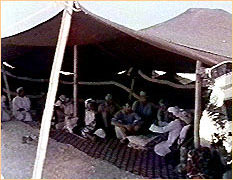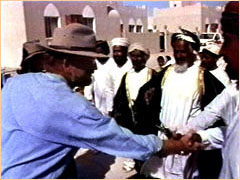 |
 |
NOVA: You shopped daily?
JZ: No, once a week. We would go to little vegetable markets and we'd pick up
bread and vegetables and sometimes frozen meats—that kind of thing.
NOVA: Any adventures with spiders or snakes?
JZ: Not really. A carpet viper did make its way into one of our supply tents
and there were camel spiders all around—but, you know, when you start making
noise and banging things around, they pretty much stay away.
NOVA: What was your favorite part of the expedition?
 JZ: The most wonderful aspect of this is how remote it is from civilization.
It's way out there in the desert. And there are beautiful sunsets. There are
huge sand dunes and the Empty Quarter isn't far away and the Bedouin are very
friendly. They were very hospitable and we'd get to sit around and drink a lot
of coffee. It's a very romantic type of atmosphere. At night you can see all
the stars. People used to bring telescopes. You could see the moons of
Jupiter with binoculars—it was so clear. And when they'd turn the generator
off, it was total silence. No one had ever experienced that kind of silence
before. No cars, no people, no television, no electricity, no airplanes going
overhead—none of that. JZ: The most wonderful aspect of this is how remote it is from civilization.
It's way out there in the desert. And there are beautiful sunsets. There are
huge sand dunes and the Empty Quarter isn't far away and the Bedouin are very
friendly. They were very hospitable and we'd get to sit around and drink a lot
of coffee. It's a very romantic type of atmosphere. At night you can see all
the stars. People used to bring telescopes. You could see the moons of
Jupiter with binoculars—it was so clear. And when they'd turn the generator
off, it was total silence. No one had ever experienced that kind of silence
before. No cars, no people, no television, no electricity, no airplanes going
overhead—none of that.
NOVA: What did the local people think of what you were doing?
 JZ: Well, at first they were kind of suspicious. They didn't know what the
heck archaeology was. But we got several people really interested and they
actually started finding sites for us. Once they knew what we were after—we
would train them—they would go out there and find sites for us. They became
really interested. JZ: Well, at first they were kind of suspicious. They didn't know what the
heck archaeology was. But we got several people really interested and they
actually started finding sites for us. Once they knew what we were after—we
would train them—they would go out there and find sites for us. They became
really interested.
NOVA: Has Shisur become something of a tourist destination?
JZ: Oh yeah. There are people there all the time from all over the world.
Journalists, TV people, ordinary tourists. I heard they're going to put up a
little hotel there and even a gas station. It's really incredible.
NOVA: You used a lot of high-tech tools on this expedition. What, in your
opinion, are the most important new tools available to archaeologists?
JZ: Brains! (laughs) No, new tools are great, but they're just that—tools. You have to be able to understand new tools and how they might help
you. But you also need old tools, like ancient manuscripts, the study of
geology, the study of climate, the study of plants and animals and all that
stuff. It's what we call the interdisciplinary approach to trying to figure
out what ancient people did or didn't do.
NOVA: What's next?
JZ: Well, I'm actually going to Yemen in January. There are sites there that
we suspect were also controlled by the Ubarites—which we think may have
similar kinds of fortresses and buildings. Ron Blom is doing more remote
sensing for us. And we've already got some of the images. We're going to try
to find precisely how well these cities stand out, if there are water sources
associated with them, if the springs are perennial, and if they have these
ancient trade routes running across them—because we know there were routes
running across there during medieval times. Now it's just a matter of getting
out there and finding the ancient ones.
To Table of Contents
Lost City Home | Remote Sensing | Interview | Desert Finds
Artifact Gallery | Map | Links
|
|
|